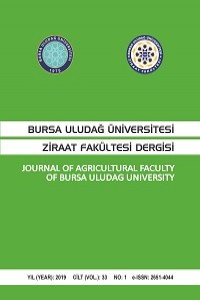Abstract
Günümüzde artarak devam eden elektrik enerjisi talebini çoğunlukla fosil yakıtları kullanarak karşılamaktayız. Ancak, bu yöntemin kullanılması ile iletim hatlarının uzunluğundan kaynaklanan kayıplar yaşanmakta, CO2 ve diğer sera gazı emisyonlarının salınımı gerçekleşmekte ve iletim hatlarının işletme ve bakım maliyetinin yüksekliği gibi zorluklarla karşılaşılmaktadır. Bu çalışma ile “Enerjinin tüketildiği yerde üretilmesi” amacıyla Uludağ Üniversitesi Ziraat Fakültesi Amfi derslik binası çatısına PV-SOL yazılımı ile 8 farklı seçenekli senaryo oluşturulmuştur. Tüm senaryolarda sırasıyla en fazla ve en düşük elektrik üretiminin temmuz ve ocak ayında gerçekleştiği, artan güneş panelleri sayısına bağlı olarak şebekeye iletilen toplam güç ve kaçınılan CO2 emisyonu oranının arttığı belirlenmiştir. Sonuç olarak, Uludağ Üniversitesi Ziraat Fakültesi tüm binaları dikkate alındığında Amfi derslik binası çatısının güneş elektriği üretimine en uygun yapı olduğu belirlenmiştir. Bu yöntem üniversitenin tüm ihtiyacını karşılamak adına diğer fakültelerin çatıları içinde geliştirilmelidir.
Keywords
References
- Gebremedhen, Y.B. 2014. Determination of optimum fixed and adjustable tilt angles for solar collectors by using typical meteorological year data for Turkey. International Journal of Renewable Energy Research, 4(4): 924-928.
- Işik, A.H., Ş. Erden and M. İmeryüz, 2015. Design of the solar energy system in ITU faculty of electric and electronics. International Conference on Renewable Energy Research and Applications, 22-25 November 2015, Palermo, Italy, p: 867-871.
- Lalwani, M., Kothari, D.P. and Singh, M. 2010. Investigation of solar photovoltaic simulation softwares. International Journal of Applied Engineering Research, 1(3): 585-601.
- Mangan, S.D. ve Oral, G.K. 2013. Türkiye’nin farklı iklim bölgelerinde bir konut binasının enerji etkin iyileştirilmesi. 11. Ulusal Tesisat Mühendisliği Kongresi, 17-20 Nisan 2013, İzmir, Türkiye, p: 921-931.
- Maturi, L., W. Sparber, B. Kofler and W. Bresciani. 2010. Analysis and monitoring results of a BIPV system in northern Italy. 25th European Photovoltaic Solar Energy Conference and Exhibition, 6-10 September 2010, Valencia, Spain, p:1-4.
- Patarau, T., D. Petreus, and R. Etz. 2015. Analysis and optimization of a geothermal, biomass, solar hybrid system: An application of PV*Sol software. 38th International Spring Seminar on Electronics Technology, 6-10 May 2015, Eger, Hungary, p: 370-375.
- Sharma, D.K., Verma, V. and Singh, A.P. 2014. Review and analysis of solar photovoltaic softwares. International Journal of Current Engineering and Technology, 4(2): 725-731.
- Srpak, D., and D. Pajan. 2016. The impact of module shading and azimuth on solar power plant production. In 25. Mednarodno Posavetovanje" Komunalna Energetika 2016", 10-12 May 2016, Maribor, Slovenia, p:1-10.
Estimating Solar Electricity Potential of Uludag University Agricultural Faculty Lecture Theater Rooftop
Abstract
Nowadays, the electricity demand is meeting mostly by using fossil fuels. However, there are difficulties of this method such as the loss of prolongation losses of transmission lines, the emission of CO2 and other greenhouse gas emissions, and the high operating and maintenance costs of transmission lines. With this study, 8 different scenarios were created with the PV-SOL software on the rooftop of the Uludag University Faculty of Agriculture Lecture Theater building in order to "produce the place where the energy is consumed". In all scenarios, the highest and lowest electricity production was realized in July and January, respectively. It has been determined that the total power delivered to the grid and the avoided CO2 emissions ratio increase due to the increased number of solar panels. As a result, considering all the buildings of the Uludag University Agricultural Faculty, it was chosen that the roof of the Lecture Theater building is the most suitable for solar electricity production. This method should be developed within the buildings of other faculties in order to meet all the electricity needs of the university.
Keywords
References
- Gebremedhen, Y.B. 2014. Determination of optimum fixed and adjustable tilt angles for solar collectors by using typical meteorological year data for Turkey. International Journal of Renewable Energy Research, 4(4): 924-928.
- Işik, A.H., Ş. Erden and M. İmeryüz, 2015. Design of the solar energy system in ITU faculty of electric and electronics. International Conference on Renewable Energy Research and Applications, 22-25 November 2015, Palermo, Italy, p: 867-871.
- Lalwani, M., Kothari, D.P. and Singh, M. 2010. Investigation of solar photovoltaic simulation softwares. International Journal of Applied Engineering Research, 1(3): 585-601.
- Mangan, S.D. ve Oral, G.K. 2013. Türkiye’nin farklı iklim bölgelerinde bir konut binasının enerji etkin iyileştirilmesi. 11. Ulusal Tesisat Mühendisliği Kongresi, 17-20 Nisan 2013, İzmir, Türkiye, p: 921-931.
- Maturi, L., W. Sparber, B. Kofler and W. Bresciani. 2010. Analysis and monitoring results of a BIPV system in northern Italy. 25th European Photovoltaic Solar Energy Conference and Exhibition, 6-10 September 2010, Valencia, Spain, p:1-4.
- Patarau, T., D. Petreus, and R. Etz. 2015. Analysis and optimization of a geothermal, biomass, solar hybrid system: An application of PV*Sol software. 38th International Spring Seminar on Electronics Technology, 6-10 May 2015, Eger, Hungary, p: 370-375.
- Sharma, D.K., Verma, V. and Singh, A.P. 2014. Review and analysis of solar photovoltaic softwares. International Journal of Current Engineering and Technology, 4(2): 725-731.
- Srpak, D., and D. Pajan. 2016. The impact of module shading and azimuth on solar power plant production. In 25. Mednarodno Posavetovanje" Komunalna Energetika 2016", 10-12 May 2016, Maribor, Slovenia, p:1-10.
Details
| Primary Language | Turkish |
|---|---|
| Subjects | Agricultural Engineering |
| Journal Section | Research Articles |
| Authors | |
| Publication Date | June 1, 2019 |
| Submission Date | April 25, 2018 |
| Published in Issue | Year 2019 Volume: 33 Issue: 1 |
Journal of Agricultural Faculty of Bursa Uludag University is licensed under a Creative Commons Attribution-NonCommercial-NoDerivatives 4.0 International License.


